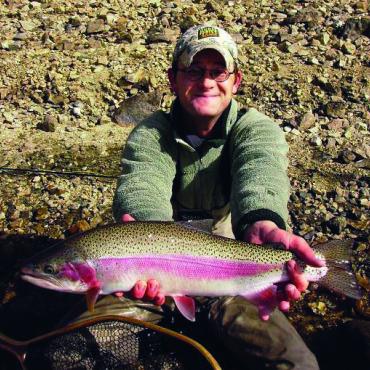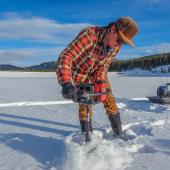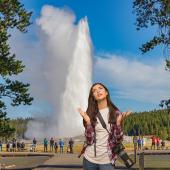Tips for Alpine Fishing
Wetting a line in Montana's high country.
As the summer months reach their peak, those good ol' secret spots and honey holes turn out to be not so sweet, and not so secret. A sure cure for those overcrowded-river blues is but a hike, horseback ride, or mountain-bike pedal to one of Montana's many secluded alpine lakes. The experience is a little different, however, so here is my list of do's and don'ts for successful alpine-lake fishing.
Do bring only one large two-sided fly box. One side should carry dry flies: Royal Wulffs, stimulators in various colors, Adams Irresistible, Griffith's Gnat, and H&L Variants. Include any other do-or-die favorites in sizes 14-20. Wet flies, nymphs, and streamers should make up the other side of the box. These should be a little smaller than your standard river flies. String leeches, seal-fur leeches, Buggers, and epoxy minnows in sizes 8-14 are proven high-altitude patterns. A dozen or so soft hackle patters in gray, olive, and tan usually prove surprisingly productive and versatile; size these similar to the above-mentioned dry fly assortment. Last, but certainly not least, both regular and bead-head nymphs in an assortment of Hare's ears, Prince nymphs, and Pheasant tails.
Do bring a neck lanyard loaded with floatant, nippers, tippet, and hemostats or clamps. I have also found a little Swiss army knife handy and useful for numerous tasks. One final necessary piece of tackle is a small container of assorted split shot.
Do pack a four-piece travel rod in 5 or 6 weight. The regular old two-piece jobs fish just fine, but packing them can be a bit of a hassle. I've also found that 9- to 10-foot rods are a bit handier on lakes because they tend to give one a bit more casting distance, which can help you access the bruisers hanging farther out from shore.
Don't treat a high-country fishing trip any differently than any other type of wilderness trip. In the backcountry, the slightest error in judgment can become deadly. Pack accordingly for drastic weather changes, emergencies, and bears, and always let someone know your destination and when to expect you back.
Don't forget that weekends are exactly that, if a truly quiet and uninterrupted experience is the goal, easily accessible and close to town trailheads might not be the best bet for a Saturday or Sunday.
Don't assume that every alpine lake is fishable, or for that matter has any fish. Some research, a quick check of the regulation booklet, or a call to FWP can save a lot of disappointment.
Do consider a float tube and full wading gear for a more productive fishing experience. The added weight is well worth the haul and can often be the difference between catching a few fish and having an epic adventure.
Don't forget the regulations. Although pan-fried trout can be the best backcountry eating, it always tastes better if harvested legally.
Do remember that these high-mountain fisheries are unique and often the last strongholds for some of Montana's native piscine species. Respect this fact and practice leave no trace and it pack in, pack it out philosophies.
Remember these simple tips and any alpine fishing trip will surely be more enjoyable and productive. For more information on rules and regulations contact Montana FWP at fwp.mt.gov, or pick up a copy of Hiking Montana (Falcon Guide), by Bill and Russ Schneider.














